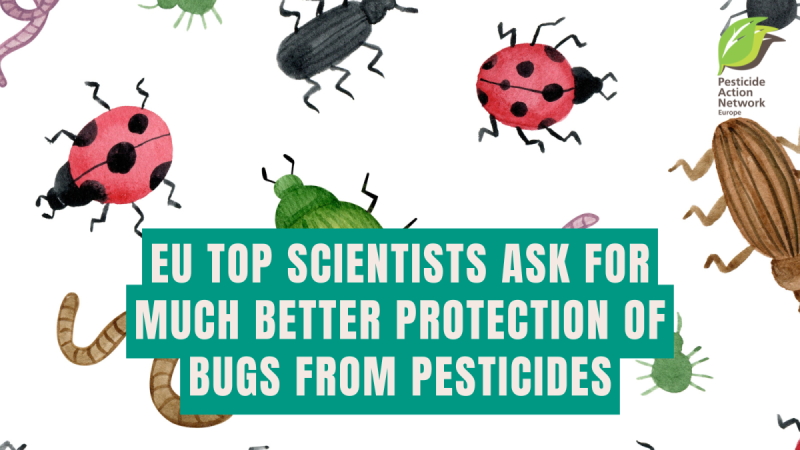In a recent letter, the European Academies' Science Advisory Council (EASAC) is demanding a complete overhaul of how the EU assesses the risks of pesticides to non-target arthropods. Their message is clear: the current approach is simply not good enough. They highlight the critical flaws in the existing guidance and lay out clear scientific recommendations to ensure the revised document leads to meaningful protection.
We often hear about the importance of bees for pollination, but a vast and diverse world of countless other tiny creatures, known as arthropods, are working tirelessly to keep our ecosystems healthy and our food systems functioning. Beetles, woodlice, millipedes, spiders and others are overlooked as mere "bugs," but they are essential linchpins. They pollinate our crops, keep our soils rich and healthy, keep harmful pests in check and provide food to countless animals, all for free
This vital workforce is in a free fall. Germany alone has lost a staggering 75% of its flying insect biomass in protected areas in around 25 years, a trend mirrored across the continent. This crisis is a direct consequence of industrial agriculture, with pesticide use as a major cause. [1] The core of the problem lies in a flawed EU guidance document that has been in use for the past 22 years. This document, which Member States and the European Food Safety Authority (EFSA) use to evaluate the risks of pesticides to arthropods, sets such weak protection standards that they are essentially meaningless. As a result, pesticides that are highly toxic to these beneficial creatures have been continuously authorised. We have highlighted this in our November 2024 Licence to Kill report. [2]
After years of inaction, these guidelines are being updated. The EFSA is now in charge of this critical revision, with a mandate from the European Commission.
A call for change from top scientists
Recognising the urgency, the European Academies' Science Advisory Council (EASAC) has stepped up to push for real change. EASAC is a powerful voice: it brings together the combined scientific expertise of the EU’s science academies to provide evidence-based advice on key policy issues to EU policymakers. In a recent and important letter to top officials at EFSA and the EU, EASAC is demanding a complete overhaul of how the EU assesses the risks of pesticides to non-target arthropods. Their message is clear: the current approach is simply not good enough.
EASAC highlights the critical flaws in the existing guidance and lays out clear scientific recommendations to ensure the revised document leads to meaningful protection for these unsung heroes of our ecosystems. This intervention matters immensely because it brings the weight of Europe's most respected scientific voices to bear on this crucial policy revision, amplifying the calls for stronger environmental safeguards and increasing the likelihood of impactful change.
Key concerns and recommendations from EASAC:
EASAC's letter raises several critical concerns about the current approach to environmental risk assessment (ERA) for non-target arthropods and offers key recommendations for improvement.
- The flawed concept of "Ecosystem Services for Humans": EASAC argues that the concept of "Ecosystem Services for Humans" (ESH) as it is currently being discussed is a scientifically unfounded simplification. They emphasise that the definition of ecosystem services already includes human relevance and that focusing solely on services directly related to agriculture ignores the broader ecological context. The interconnectedness of agriculture with various ecosystem services and biodiversity objectives must be acknowledged.
- Rigorous testing procedures: The letter emphasises the importance of robust testing procedures, including:
- Selecting test species that represent a range of sensitivity and ensuring data availability in pesticide dossiers.
- Testing for cumulative and long-term impacts, not just short-term exposure.
- Accounting for the potential for combined toxic effects from exposure to multiple pesticides and co-formulants simultaneously (cocktail exposure). EASAC suggests a more systems-based ERA to address these shortcomings.
- Rethinking population recovery: EASAC challenges the assumption of automatic population recovery of depleted arthropod populations. They point out that recovery may not be possible due to the absence of source populations in intensive agricultural landscapes and the widespread decline of arthropods, even in protected areas.
PAN Europe strongly echoes the concerns raised by EASAC. The EASAC letter provides compelling evidence that the current system is failing to protect vital arthropod populations and that urgent action is needed to revise the EFSA guidance document.
The revision of the EFSA guidance document is a crucial opportunity to protect our vital arthropod allies. The scientific community, as represented by EASAC, has spoken clearly: we need a fundamental shift towards more rigorous and ecologically sound pesticide risk assessments. Let's ensure that this revision leads to real change on the ground and safeguards the future of these essential creatures.
Further reading
- EASSAC Letter. (2025, February 19). Environmental risk assessment for non-target arthropods [addressed to Dr. Bernhard Url and Dr. Sandra Gallina].
Notes
[1] Sánchez-Bayo, F., & Wyckhuys, K. A. G. (2019). Worldwide decline of the entomofauna: A review of its drivers. Biological Conservation, 232, 8–27. https://doi.org/10.1016/j.biocon.2019.01.020
[2] Licence to Kill - an EU guideline with far-reaching consequences (PAN Europe, November 2024)
